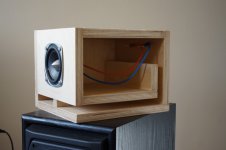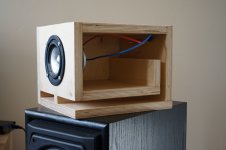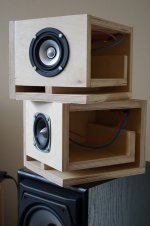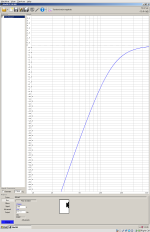I'm building a pair of small 'satellite' speakers with 3" Tang Band drivers to go with the sub I built a few months ago (with an 8" Tang Band driver). I designed/simulated the cabinets for the W3-926SD but I also have a pair of W3-871C (I ordered the very popular W3-871S but they sent me the C which appear the same but lack the phase plug). The design is flat to 125Hz, -3dB at 95Hz, with the 926SD.
I just played some music through them for the first time, with one of each driver loaded & the missing sides clamped in position & am very disappointed 🙁 The 926 sound as if they are mounted in a tin can, the 871 are better but both are massively lacking in the low mid regions & the very high frequencies. They certainly can't replace my old Mission 732 standmount speakers yet, as I originally intended.
What can I do to improve them? Will stuffing/wadding help? Notch filter? Can I add a tweeter with a simple crossover? Is the design plain wrong somehow? Or am I just expecting too much from these drivers?
I'm going to try to use a software equalizer to see if I can get them sounding better, but I'm really hoping somebody has some advice!
I just played some music through them for the first time, with one of each driver loaded & the missing sides clamped in position & am very disappointed 🙁 The 926 sound as if they are mounted in a tin can, the 871 are better but both are massively lacking in the low mid regions & the very high frequencies. They certainly can't replace my old Mission 732 standmount speakers yet, as I originally intended.
What can I do to improve them? Will stuffing/wadding help? Notch filter? Can I add a tweeter with a simple crossover? Is the design plain wrong somehow? Or am I just expecting too much from these drivers?
I'm going to try to use a software equalizer to see if I can get them sounding better, but I'm really hoping somebody has some advice!
Attachments
Last edited:
Not sure about those particular drivers but a lot of full rangers need some hours on them before you can really evaluate their sound. Some may require 200 hrs or more.
It's hard to say, what are some more detailed specs on the cabinet and drivers. Also if you have a frequency response it would help a lot, even just from your computer sound card would give us a good idea of the trends.
I probably would have tuned a bit lower aiming for an f3 in the 70s or 80s but that's just me. When you tested them did you have the sub on? I've found that even if the upper and midrange sound great without a low end it sounds really bad. Maybe if you test with the sub you will be surprised. I know i was when I built my first speakers, I thought they didn't sound very good right up until I set up the sub and i thought they were great
I probably would have tuned a bit lower aiming for an f3 in the 70s or 80s but that's just me. When you tested them did you have the sub on? I've found that even if the upper and midrange sound great without a low end it sounds really bad. Maybe if you test with the sub you will be surprised. I know i was when I built my first speakers, I thought they didn't sound very good right up until I set up the sub and i thought they were great
Not sure about those particular drivers but a lot of full rangers need some hours on them before you can really evaluate their sound. Some may require 200 hrs or more.
This is also true. Many drivers sound much better after a bit of time. After about 100 hours my sub sounds totally different than when i turned it on for the first time
So there's nothing that immediately jumps out as being a bad design? I was hoping I was just doing something wrong 🙂
Cabinets are 2.7l, 2x slot ports 78x15mm & 26cm long. The wood is 15mm 13 laminate plywood, which is thicker than I originally intended but I knew a guy with plenty of 15mm offcuts so I scaled up the design. TS for the 926 are here, I don't have TS for the 871C (it doesn't seem to officially exist, all results are for the 871S).what are some more detailed specs on the cabinet and drivers.
Are you asking if I can measure the frequency response with a mic?Also if you have a frequency response it would help a lot, even just from your computer sound card would give us a good idea of the trends.
Well it certainly sounds better with the sub, but it still doesn't sound 'good'. Vocals in particular sound really 'subdued' or 'muffled' for want of better words... If I put quite a bit of volume through them with some dance music they don't sound too bad, but as soon as somebody starts singing it sounds awful.When you tested them did you have the sub on? I've found that even if the upper and midrange sound great without a low end it sounds really bad. Maybe if you test with the sub you will be surprised. I know i was when I built my first speakers, I thought they didn't sound very good right up until I set up the sub and i thought they were great
Did you use any speaker design software or your box dimensions and port tuning is arbitrary?
You will also need some lining material - otherwise reflections from the insides of the cabinets might garble things up.
Did you listen to the drivers before you put them in the cabs?
You will also need some lining material - otherwise reflections from the insides of the cabinets might garble things up.
Did you listen to the drivers before you put them in the cabs?
Are you asking if I can measure the frequency response with a mic?
With REW you can measure response with just a laptop with no extra hardware. Its not very accurate but its better than nothing. If you have a calibrated Mic that would of course be better.
Well it certainly sounds better with the sub, but it still doesn't sound 'good'. Vocals in particular sound really 'subdued' or 'muffled'forwant of betterwords... IfI put quitea bitof volumethroughthem with some dance music they don't sound too bad, but as soon as somebody starts singing it sounds awful.
It sounds like stuffing will help a lot of the problem is what I think it is. If its not stuffed then unwanted midrange information can come out of the port that can make it sound not great. Also as was said reflections can come through the cone and mess things up even more.
My suggestion is to stuff it. Let it break in for a while. If it still sounds bad then it might be something wrong with the driver. A way you could rule out it being an issue with midrange coming out of the port is to plug the port temporary, if the midrange problem goes away, you've found your problem, and some strategic stuffing can help
Your port is 26cm long. It gives the first port resonance at 660Hz . This resonance is looking like 15-20db bump and similar hole at FR curve before or after this bump . Such thing sounds like a hollow can. And of course the low frequencies also are masked by those loud background notes
I don’t have a recipe for vented full-range speaker. In my subjective opinion this port could be in two times smaller for this box and this speaker. At higher frequencies this resonance is weaker and can be easier dampened by stuffing the port by polyfill.
As for the high frequencies sparkle, smallest twitter (let say 0.5 ’’ playing from 6-8 kHz) could help here.
I don’t have a recipe for vented full-range speaker. In my subjective opinion this port could be in two times smaller for this box and this speaker. At higher frequencies this resonance is weaker and can be easier dampened by stuffing the port by polyfill.
As for the high frequencies sparkle, smallest twitter (let say 0.5 ’’ playing from 6-8 kHz) could help here.
but both are massively lacking in the low mid regions & the very high frequencies.
Hi,
A BSC filter R and parallel L will flatten out the low midrange. You can then
add a further parallel series R and C to manipulate the higher treble, but
neither approach will fix driver peaks that need their own notch filter.
See Zaphaudio.com for 3" FR stuff, but unfortunately he's totally pulled
his comprehensive (old) write up of the W3-871 and I don't have a copy.
rgds, sreten.
I used WinISD but have little-to-no prior experience in designing boxes so only know the very basics of it.Did you use any speaker design software or your box dimensions and port tuning is arbitrary?
This is what I was talking about when I asked if there were any obvious problems with my design. I have no idea what the first port resonance is, so didn't pay it any attention in WinISD which has led me to this...Your port is 26cm long. It gives the first port resonance at 660Hz . This resonance is looking like 15-20db bump and similar hole at FR curve before or after this bump . Such thing sounds like a hollow can. And of course the low frequencies also are masked by those loud background notes
I don’t have a recipe for vented full-range speaker. In my subjective opinion this port could be in two times smaller for this box and this speaker. At higher frequencies this resonance is weaker and can be easier dampened by stuffing the port by polyfill.
So what's my best option? Should I be considering permanently filling one of the ports in addition to adding stuffing?
You may want to remove some material from the back of the baffle to make sure the driver can breathe freely. Maybe chamfer or rabbet it to keep the thickness about 8-10mm near the driver, if you haven't already done so.
Last edited:
I think you are asking too much from a 3" speaker, no matter what brand.
They gave some advice to band-aid the situation, but I don't think it will ever sound like you expect.
Would make a decent computer setup though.
They gave some advice to band-aid the situation, but I don't think it will ever sound like you expect.
Would make a decent computer setup though.
So what's my best option? Should I be considering permanently filling one of the ports in addition to adding stuffing?
Dampening by polyfill works worse for lower frequencies.
As a side note, the strength of this resonance depends on ratio between box and port size.
Leave only one slot, and reduce the length in two times. It will be 11 cm2 port.
Modeled in Unibox program for Fb 85hz ,the 15cm long port with 11cm2 internal area gives air velocity 18m/s at 12watt and first port resonance at 1150Hz.
Further, you can insert thin pad, 2-3cm from polyfill, at a distance of 1/3 of port lenght, it will help to split the main resonance and to redirect part of energy into it’s harmonics.
Back to post 10, I think you got way off track with the huge port(s) idea, my guess is that sound is just pouring out of them, canceling out the sound from the front.
This is an interesting build using the same speaker:
www.vikash.info/audio/W3-871S/build.asp
This is an interesting build using the same speaker:
www.vikash.info/audio/W3-871S/build.asp
Dampening by polyfill works worse for lower frequencies.
As a side note, the strength of this resonance depends on ratio between box and port size.
Leave only one slot, and reduce the length in two times. It will be 11 cm2 port.
Modeled in Unibox program for Fb 85hz ,the 15cm long port with 11cm2 internal area gives air velocity 18m/s at 12watt and first port resonance at 1150Hz.
Further, you can insert thin pad, 2-3cm from polyfill, at a distance of 1/3 of port lenght, it will help to split the main resonance and to redirect part of energy into it’s harmonics.
I'll have a think how I can do that. As it's all glued together apart from the one side making alterations to the ports won't be easy, but I should be able to Dremel the one on the open side.
I followed the dimensions from WinISD, but as I said I couldn't know whether WinISD was leading me astray...Back to post 10, I think you got way off track with the huge port(s) idea, my guess is that sound is just pouring out of them, canceling out the sound from the front.
I saw that & several others like it when I was coming up with my original design, but when I put them into WinISD the frequency response was dreadful! Vikash's cabinets are roughly 2.8l, which is the same as mine if I completely filled the ports, but the plot from WinISD is attached for this & (to my unexperienced eyes at least) is useless!
Attachments
Okay, it looks to me like...
- you need a baffle step filter - when the driver goes from "seeing" the baffle to not seeing the baffle, it loses an amount of energy as the sound wraps around the cabinet. At higher frequencies, the driver is effectively in half-space, at LF, its in full space. Out in a field, this transition will lose 6dB. In the home, 4dB seems more common. There are online calculators that will help you calculate the components needed.
- that cabinet isn't going to work as simulated - high aspect ratio ports with sharp folds aren't going to allow airflow so easily, reducing bass output compared to what winISD said.
- you may well be expecting too much from a small driver - comparing them to a larger 2-way and expecting them to do what the 2-ways do with bass and treble isn't fair: FR drivers are generally about the midrange.
- you need to let them bed in (as others have said).
Here's how I do it...
Download a bass-heavy track. Bass I Love You, 15 Step by Radiohead, whatever. Something to get the cones moving.
Put the cabinets face to face and wire one backwards. That way, the sound cancels out, so you're not disturbed so much (add a blanket over them if there's still noise getting out). Play the bassy track through on repeat, set off so you can just about see the cones moving, leave it a couple of hours, then have another listen. Turn it up so they're moving a few mm peak to peak, leave for a couple of hours, listen again. Take them up to rated Xmax (not recommended for Mark Audio stuff: the rated Xmax is way beyond what they should be driven to, due to the fragile cones), leave for a few hours, listen again.
Repeat the last stage a few times over for good measure.
By that time, they should be somewhere near their final operating condition.
Hope this helps.
Chris
PS - where abouts in the UK are you?
- you need a baffle step filter - when the driver goes from "seeing" the baffle to not seeing the baffle, it loses an amount of energy as the sound wraps around the cabinet. At higher frequencies, the driver is effectively in half-space, at LF, its in full space. Out in a field, this transition will lose 6dB. In the home, 4dB seems more common. There are online calculators that will help you calculate the components needed.
- that cabinet isn't going to work as simulated - high aspect ratio ports with sharp folds aren't going to allow airflow so easily, reducing bass output compared to what winISD said.
- you may well be expecting too much from a small driver - comparing them to a larger 2-way and expecting them to do what the 2-ways do with bass and treble isn't fair: FR drivers are generally about the midrange.
- you need to let them bed in (as others have said).
Here's how I do it...
Download a bass-heavy track. Bass I Love You, 15 Step by Radiohead, whatever. Something to get the cones moving.
Put the cabinets face to face and wire one backwards. That way, the sound cancels out, so you're not disturbed so much (add a blanket over them if there's still noise getting out). Play the bassy track through on repeat, set off so you can just about see the cones moving, leave it a couple of hours, then have another listen. Turn it up so they're moving a few mm peak to peak, leave for a couple of hours, listen again. Take them up to rated Xmax (not recommended for Mark Audio stuff: the rated Xmax is way beyond what they should be driven to, due to the fragile cones), leave for a few hours, listen again.
Repeat the last stage a few times over for good measure.
By that time, they should be somewhere near their final operating condition.
Hope this helps.
Chris
PS - where abouts in the UK are you?
I didn’t see that being a fair comparison either (it’s not that easy). The Mission 732 appears to have to good reviews, a bigger woofer and a tweeter for highs.
As far as what do now, I would try to improve on a previous design, e.g. a 2.8L triangle box, try to make the front small as possible.
btw, I'm really happy with a recent FR Fostex build using these:
Fostex FF125WK 5" Full Range: Madisound Speaker Store
As far as what do now, I would try to improve on a previous design, e.g. a 2.8L triangle box, try to make the front small as possible.
btw, I'm really happy with a recent FR Fostex build using these:
Fostex FF125WK 5" Full Range: Madisound Speaker Store
- you may well be expecting too much from a small driver - comparing them to a larger 2-way and expecting them to do what the 2-ways do with bass and treble isn't fair: FR drivers are generally about the midrange.
QUOTE]
Hi Lost Eden, the 26 lenth of the port, is that including the fold ? What is the hight and depth of the box the port not includet?
In other words, I would like alle the internal dimesions and fire up MJK´s excelent simulation models.
In the meantime, please take a look at my foldet version of TABAQ. As you can see, the volume is much larhes than yoru design.
Hi from
Bjorn J
In other words, I would like alle the internal dimesions and fire up MJK´s excelent simulation models.
In the meantime, please take a look at my foldet version of TABAQ. As you can see, the volume is much larhes than yoru design.
Hi from
Bjorn J
Attachments
Im mid progress in something similar myself. I would just re-iterate what others have said, the points that i agree with.
Ports= too big cross sectional area and/or too long and/or the bend doesnt help much.
ALso, It may have even been better sounding with a rear firing port, identical to the one you have now.POSSIBLY a fairly easy mod.
I have a 2" round port on a pair of 5"ers in 17litre cabs. one has a rear port the other on the front. Even with the port spaced some 8" away, the front ported box radiates more midrange hash from the inside of the cab.
Also, I reckon the port is too close to the driver itself. As others said, there will be cancellation. the large this distance is, the better for eliminating cancellation.
I seem to recall reading a 'rule of thumb' of minimum 3" between driver and port, although that maybe have been in reference to the 'inside' end and its proximity to rear walls, the rear of the driver etc.
Hence why the rear firing port works well, but is difficult on a micro speaker. Maybe you could reduce the area of the port, but then without also shortening it, the tuning will be even lower, and bass weaker. With these drivers (I have the W3-1285sg) Ive used a small port, and given the low relative SPLs I would suggest that even a 'simple port' ie a hole, would work, IF the volume required for a port area of maybe 100mm² or so, wasnt too large.
RUN IN
Run in time is definitely a big factor with these drivers, BUT theyre never going to shake the windows. The change in the driver Vas and Qts MAY work in your favour, however small it may be. I dont understand why MA drivers are so cautious about the run in. Yes theyre fragile cones, but does it mean I can NEVER let them get up to 1mm pk-pk movement for fear of damaging? speakers that you ruin by LISTENIng to them.....paradoxical indeed.
Ports= too big cross sectional area and/or too long and/or the bend doesnt help much.
ALso, It may have even been better sounding with a rear firing port, identical to the one you have now.POSSIBLY a fairly easy mod.
I have a 2" round port on a pair of 5"ers in 17litre cabs. one has a rear port the other on the front. Even with the port spaced some 8" away, the front ported box radiates more midrange hash from the inside of the cab.
Also, I reckon the port is too close to the driver itself. As others said, there will be cancellation. the large this distance is, the better for eliminating cancellation.
I seem to recall reading a 'rule of thumb' of minimum 3" between driver and port, although that maybe have been in reference to the 'inside' end and its proximity to rear walls, the rear of the driver etc.
Hence why the rear firing port works well, but is difficult on a micro speaker. Maybe you could reduce the area of the port, but then without also shortening it, the tuning will be even lower, and bass weaker. With these drivers (I have the W3-1285sg) Ive used a small port, and given the low relative SPLs I would suggest that even a 'simple port' ie a hole, would work, IF the volume required for a port area of maybe 100mm² or so, wasnt too large.
RUN IN
Run in time is definitely a big factor with these drivers, BUT theyre never going to shake the windows. The change in the driver Vas and Qts MAY work in your favour, however small it may be. I dont understand why MA drivers are so cautious about the run in. Yes theyre fragile cones, but does it mean I can NEVER let them get up to 1mm pk-pk movement for fear of damaging? speakers that you ruin by LISTENIng to them.....paradoxical indeed.
Last edited:
- Status
- Not open for further replies.
- Home
- Loudspeakers
- Full Range
- Disappointing first build w/ W3-871C W3-926SD



